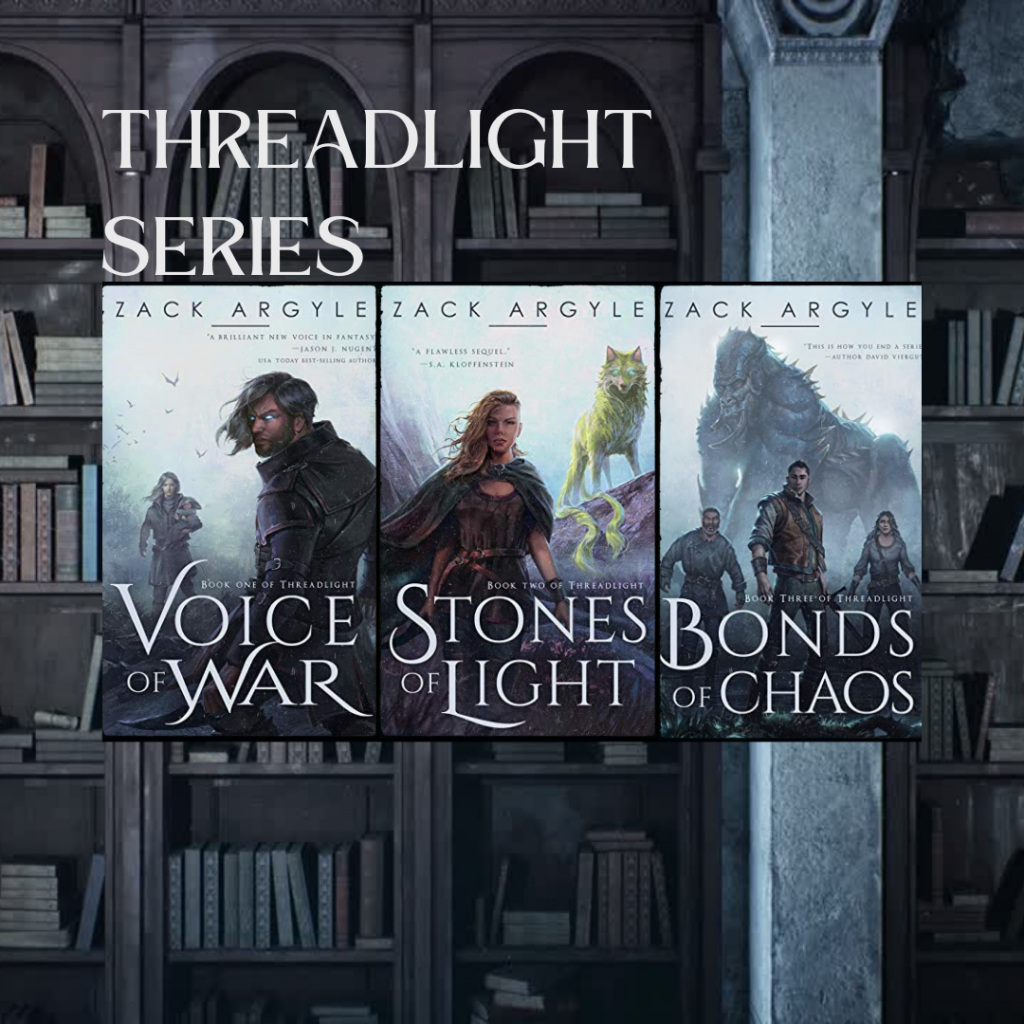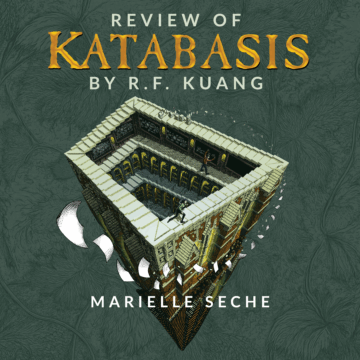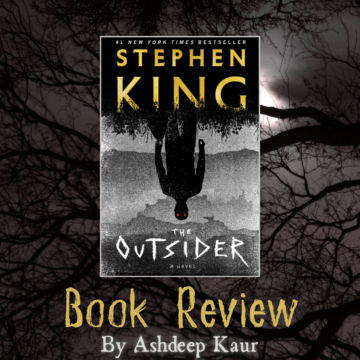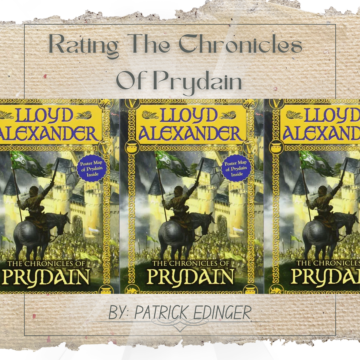
A world with cool eye colors tied to powers, a cast that could make you think about your own interactions with people, and a narrative that comes with a really cool map. —Patrick Edinger
Good evening to anyone reading. I hope you found this in good health. For this piece, I will be detailing a review of the newer trilogy, Threadlight, by Zack Argyle. Threadlight, if anyone’s mind was bursting with wonder, is a fantasy story set on The Continent of Arasin. Arasin is a large body of land filled to the brim with various mythical and magical creatures, as well as bustling settlements to match. Within this world bloated with legends, magics, and fiends, lies the beginning of our story. The beginning of the journey.
The Threadlight series follows three individual characters fated to have a bigger purpose as one, though their paths to uniting were arduous. The series begins with an introduction of three key figures for the story. Chrys Valerian, a High General of the nation of Alchea tasked with hunting down the notorious terrorists the Bloodthieves. Laurel of Zedalum, a free spirited Fariean child who hails from the hidden tree-top city of Zedalum. And Alverax, a charismatic mystery man who inexplicably awakes in the middle of the barren and scorching Silkar Desert. These characters begin as individuals and then, once they reach their intended design, fate draws them in. The entire world as we grow to know it is in danger, and it will take an ex-soldier with an unstable psyche, a rebellious teenage girl with her pet wolf, and an amnesiac hell-bent on finding out who he was to save it. By the end of this journey, anybody would be curious toward what Zack Argyle will publish next.
The entire world as we grow to know it is in danger, and it will take an ex-soldier with an unstable psyche, a rebellious teenage girl with her pet wolf, and an amnesiac hell-bent on finding out who he was to save it.
This trilogy is only one of many fantasy stories and it holds many similarities to others before it. Whether it’s the intricate magic system that plays into deepening world lore, the bonds of chaos that bind the main characters to each other, or the open world feeling to the story as a whole. There is something in the story that Argyle presents that will please fantasy lovers. Though, if fantasy isn’t your main choice, I understand. But, that doesn’t mean the book isn’t for you. Many audiences could enjoy this strictly due to how much is in this world. Whether it’s the fascination with world lore/mythos, the inclusion of varying writing techniques and tropes, or the varying character integration, Argyle presents something for many, especially fantasy readers.
For this story there are a lot of things to like and dislike equally, making it fairly balanced, for the lack of a better phrase. To start off on a positive note, the likes of this story are consistent through all three books; which, if nothing else, Argyle is consistent. The story’s strong points tended to bleed through the page and into the reader when the characters were the main focus of the story. Specifically, the individuals themselves and their own stories. They were strongest together, during the parts when they were all together, and it was enjoyable to watch. The characters in the trilogy were believable and, despite one of them falling heavily into a cliche, Argyle worked them in to play off each other’s strengths and weaknesses, reminiscent of how real life relationships can be. Each character felt like an individual waiting to be explored, where there was much more than meets the eye. And by the end of it, even the more unlikable or unexpected side characters seemed to gel this makeshift family together. In addition to the characterization, the world building, including the magic system, was well-planned out and explained through each character seamlessly. Each detail was orchestrated to make the reader want to delve deeper into the pages out of intrigue.
Each character felt like an individual waiting to be explored, where there was much more than meets the eye.
Now, it’s time to get a bit negative. But positively negative, a respectful negative that, believe it or not, can be quite constructive. To reiterate quickly, the books overall have some good, very bright parts that shine. However, all of this is shrouded by one main difficult style Argyle chooses to adapt in his books: alternate point of view. This style, while it can be good, only seemed to slow the story down—and noticeably. A chapter could begin with an interesting character with a gripping plot that is just beginning to crescendo and then, the story will switch to another point of view. It is as if the author is consistently killing his own built up momentum through this style for a reason unknown. A perfect example of this was the first book’s three beginning chapters. Chrys, the pseudo-main character for those first three chapters, is exploring an abandoned warehouse when he finds something that causes the narrative to begin revving its engine. The narrative then takes off as chaos ensues, someone gets attacked, another stabbed, and then at the end of it all, when all hope seems lost, Chrys finds a clue to push the story along. And right before it can, right before Chrys is able to make something of his discovery, it switches to another character, in a setting entirely opposite of the one prior. It’s like an adrenaline rush of excitement, but there is no outlet to let all of that built up energy flow; it’s unfulfilling. Having good characters with a gripping plot is very important, and can be difficult to perform. But not letting those characters unfurl at their own pace, not letting the plot develop quickly, and purposefully slowing the entire narrative down is not worth the varying perspectives. Now that perspective is out of the way, let’s discuss the other main weakness the trilogy has. The actual narrative voice itself.
Due to the way the narrative is written, oftentimes, it can be seen as one-dimensional. The writing is literal in many ways as well as predictable. Predictability is not bad by any stretch of the imagination, but control over its predictability is the key to this, and the story did not have control. With a narrative that doesn’t try to mask many things from the reader, it’s a bit too straightforward, a bit too clear. Ambiguity in stories is why readers continue to read until the end, and promoting this unknown factor is important—which the narrative does very little. In addition, oftentimes there are points in the narrative that “tell” you to death. There is so much telling in this story that the moments the author “shows” are dwarfed by the sheer amount of telling the author does throughout the whole story. A balance is very good, especially when it comes to Showing and Telling.
With a narrative that doesn’t try to mask many things from the reader, it’s a bit too straightforward, a bit too clear.
Fundamentally, the story succeeds at what it was set out to do and that was to explore the world presented in Threadlight, along with its three main characters to stop a greater evil. Overall, it wasn’t bad or good. It was a fairly simple read that felt uncertain about its own pacing. At times, the narrative can fly on by, and at other times it’s a snail’s crawl. The book can be enjoyable as a simple, easy read that isn’t a very dynamic story to have to think very hard about. It’s one that, if you are wishing for it, you will enjoy. If you are not, and are looking for the exact opposite, it will be excruciating.
Order the Threadlight Trilogy today from Amazon.


